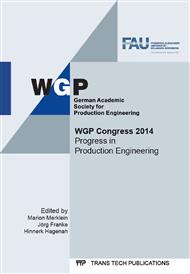[1]
E. Brinksmeier, Prozeß- und Werkstückqualität in der Feinbearbeitung, VDI-Verlag, Düsseldorf, (1991).
Google Scholar
[2]
B. Denkena, H. K. Tönshoff, Spanen: Grundlagen, 3. Auflage, Springer DE, Berlin, (2011).
Google Scholar
[3]
S. Malkin, Ch. Guo, Grinding Technology: Theory and Applications of Machining with Abrasives, 2. Edition, Industrial Press, New York, (2008).
Google Scholar
[4]
M. A. Davies, T. Ueda, R. M'Saoubi, B. Mullany, A. L. Cooke, On The Measurement of Temperature in Material Removal Processes, CIRP Annals - Manufacturing Technology, Volume 56, Issue 2, 2007, pp.581-604.
DOI: 10.1016/j.cirp.2007.10.009
Google Scholar
[5]
C. Heinzel, Schleifprozesse verstehen: Zum Stand der Modellbildung und Simulation sowie unterstützender experimenteller Methoden, Shaker Verlag, Aachen, (2009).
Google Scholar
[6]
E. Brinksmeier, J. C. Aurich, E. Govekar, C. Heinzel, H. - W. Hoffmeister, F. Klocke, J. Peters, R. Rentsch, D. J. Stephenson, E. Uhlmann, K. Weinert, M. Wittmann, Advances in Modeling and Simulation of Grinding Processes, CIRP Annals - Manufacturing Technology, Volume 55, Issue 2, 2006, pp.667-696.
DOI: 10.1016/j.cirp.2006.10.003
Google Scholar
[7]
C. Heinzel, J. Sölter, S. Jermolajev, B. Kolkwitz, E. Brinksmeier, A Versatile Method to Determine Thermal Limits in Grinding, Procedia CIRP, Volume 13, 2014, pp.131-136.
DOI: 10.1016/j.procir.2014.04.023
Google Scholar
[8]
M. Duscha, F. Klocke, A. d'Entremont, B. Linke, H. Wegner, Investigation of Temperatures and Residual Stresses in Speed Stroke Grinding via FEA Simulation and Practical Tests, Journal Proceedings in Manufacturing Systems, Vol. 5, 2010, No. 1 / 1-10.
Google Scholar
[9]
E. Brinksmeier, C. Heinzel, A. Wilkens, E. Giese, Werkzeugseitige Temperaturmessung beim Schleifen, Jahrbuch Schleifen, Honen, Läppen und Polieren, 64. Ausgabe, Vulkan-Verlag, Essen 2008, pp.224-238.
DOI: 10.1002/maco.19790300419
Google Scholar
[10]
M., Sakakura, T. Ohnishi, T. Shinoda, K. Ohashi, S. Tsukamoto, I. Inasaki, Temperature distribution in a workpiece during cylindrical plunge grinding, Production Engineering - Research and Development, Volume 6, Issue 2, 2012, pp.149-155.
DOI: 10.1007/s11740-012-0372-z
Google Scholar
[11]
S. Malkin, Ch. Guo, Thermal analysis of grinding, CIRP Annals - Manufacturing Technology, Volume 56, Issue 2, 2007, pp.760-782.
DOI: 10.1016/j.cirp.2007.10.005
Google Scholar
[12]
B. Karpuschewski, Mikromagnetische Randzonenanalyse geschliffener einsatzgehärteter Bauteile, VDI-Verlag, Düsseldorf, (1995).
Google Scholar
[13]
D. J. Stephenson, T. Jin, Physical Basics in Grinding, 1st European conference on grinding, Edt. K. Werner, F. Klocke, E. Brinksmeier, Fortschrittsberichte, VDI-Verlag, Aachen, 2003, pp.1301-1321.
Google Scholar
[14]
M. Duscha, A. Eser, F. Klocke, C. Broeckmann, H. Wegner, A. Bezold, Modeling and Simulation of Phase Transformation during Grinding, Advanced Material Research, Volume 223, 2011, pp.743-753.
DOI: 10.4028/www.scientific.net/amr.223.743
Google Scholar
[15]
T. Foeckerer, B. Kolkwitz, C. Heinzel, M. F. Zaeh, Experimental and Numerical Analysis of transient behavior during grind-hardening of AISI 52100, Production Engineering - Research and Development, Volume 6, Issue 6, 2012, pp.559-568.
DOI: 10.1007/s11740-012-0414-6
Google Scholar


